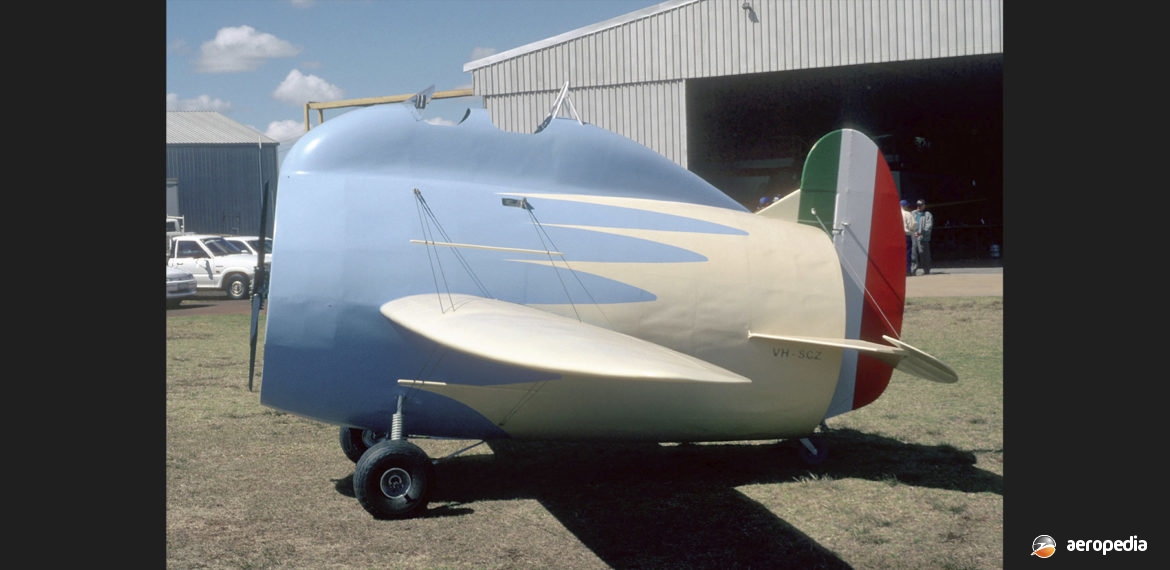Photograph:
Stipa Caproni replica VH-SCZ (c/n SC1-R) at Toowoomba, QLD (Tony Arbon)
Country of origin:
Italy
Description:
Light experimental aircraft
Power Plant:
(Replica)
One 54 kw (72 hp) Simonini 584R1 90-degree VEE two-cylinder, two-stroke, racing engine
Specifications:
- Wingspan: 14.30 m (46 ft 10 in)
- Length: 5.92 m (19 ft 5 in)
- Height: 3.24 m (10 ft 7 in)
- Max speed: 130 km/h (81 mph)
- Landing speed: 68 km/h (42 mph)
History:
In about 1932 an unusual aircraft was designed in Italy by Mr Luigi Stipa and built by Caproni, at one stage being claimed to be the first Italian jet-aircraft to fly. However, power was in fact provided by a piston engine driving a three-stage variable-pitch fan within the hollow fuselage, the system being that air was forced through the internal tubular-shaped duct within the fuselage and out through a variable nozzle at the end of a jet pipe into which raw fuel was injected and burned to increase the thrust provided.
The design was found to be a success but the aircraft built was too heavy for the power provided by the engine and the Stipa Caproni, along with its successor, the Caproni Campini N.1, was later scrapped. Although the design was one of many hundreds of aeronautical designs which evolved during the 1930s, it like many others faded into oblivion but has since received some recognition as an early effort aimed at the development of jet propulsion technology. It is reported it had exceptional stability throughout the entire flight envelope. The prototype’s crew sat in a bulge on top of the fuselage, and it had a max speed of 130 km/h (81 mph) and a landing speed of 68 km/h (42 mph).
In 1996 the late Guido Zuccoli commissioned the construction of a 65% scale replica of the Stipa Caproni ducted fan aircraft. Construction was by Bryce Wolff for Aerotec Pty Ltd. However, construction had not been completed when Mr Zuccoli was killed in a forced landing in a North American Harvard and work subsequently proceeded under the guidance of his wife, Lynette, as a personal tribute to his achievements in the field of aviation. Completed in 2001, the machine was the subject of a series of high-speed taxiing trials at Toowoomba, QLD on 22 October that year to gauge the handling qualities of the machine. Whereas the original machine designed by Luigi Stipa had a 90 kw (120 hp) de Havilland Gipsy III engine, and was flown for the first time in 1931, the scale replica was fitted with a 54 kw (72 hp) Simonini racing engine driving a four-blade propeller.
Bryce Wolff, satisfied with the responses to control input, and the power developed by the engine, made a short test flight on that occasion, the distance flown being recorded at some 250 m (820 ft). Further test flights were made on 25 October 2001 and on this occasion a distance of approximately 300 m (984 ft) and a height of three m was achieved. Registration VH-SCZ (c/n SC1-R) was allotted and additional test flights were later conducted at the nearby Jondaryan glider strip. One flight was recorded of 600 m (1,968 ft).
Much effort went into faithfully producing the original colour scheme and markings. The machine was of unusual configuration and shape, and was a radical departure from conventional designs. It was considered by some to have paved the way towards the use of jet propulsion. In the event ducted-fan technology, although used in a number of designs, has never really proceeded to mass-production level. The replica is on display with the Zuccoli collection at Toowoomba, QLD.

